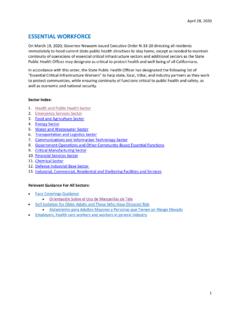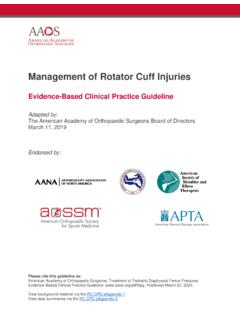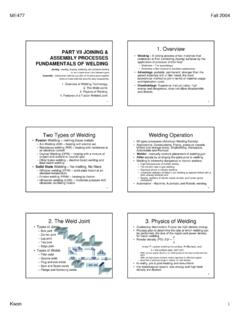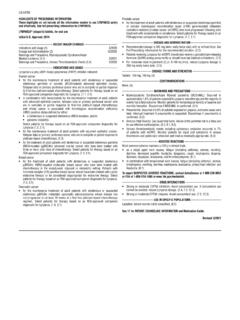Transcription of Guideline: Primary postpartum haemorrhage
1 Maternity and NeonatalClinical GuidelineQueensland Health Clinical Excellence Queensland Primary postpartum haemorrhage Queensland Clinical Guideline: postpartum haemorrhage Refer to online version, destroy printed copies after use Page 2 of 37 Document title: Primary postpartum haemorrhage Publication date: March 2018 Document number: Document supplement: The document supplement is integral to and should be read in conjunction with this guideline. Amendments: Full version history is supplied in the document supplement. Amendment date: July 2021 Replaces document: Author: Queensland Clinical Guidelines Audience: Health professionals in Queensland public and private maternity and neonatal services Review date: December 2023 Endorsed by: Queensland Clinical Guidelines Steering Committee Statewide Maternity and Neonatal Clinical Network (Queensland) Contact: Email: URL: Disclaimer This guideline is intended as a guide and provided for information purposes only.
2 The information has been prepared using a multidisciplinary approach with reference to the best information and evidence available at the time of preparation. No assurance is given that the information is entirely complete, current, or accurate in every respect. The guideline is not a substitute for clinical judgement, knowledge and expertise, or medical advice. Variation from the guideline, taking into account individual circumstances, may be appropriate. This guideline does not address all elements of standard practice and accepts that individual clinicians are responsible for: Providing care within the context of locally available resources, expertise, and scope of practice Supporting consumer rights and informed decision making, including the right to decline intervention or ongoing management Advising consumers of their choices in an environment that is culturally appropriate and which enables comfortable and confidential discussion.
3 This includes the use of interpreter services where necessary Ensuring informed consent is obtained prior to delivering care Meeting all legislative requirements and professional standards Applying standard precautions, and additional precautions as necessary, when delivering care Documenting all care in accordance with mandatory and local requirements Queensland Health disclaims, to the maximum extent permitted by law, all responsibility and all liability (including without limitation, liability in negligence) for all expenses, losses, damages and costs incurred for any reason associated with the use of this guideline, including the materials within or referred to throughout this document being in any way inaccurate, out of context, incomplete or unavailable. Recommended citation: Queensland Clinical Guidelines.
4 postpartum haemorrhage Guideline No. Queensland Available from: State of Queensland (Queensland Health) 2021 This work is licensed under a Creative Commons Attribution-NonCommercial-NoDerivatives International licence. In essence, you are free to copy and communicate the work in its current form for non-commercial purposes, as long as you attribute Queensland Clinical Guidelines, Queensland Health and abide by the licence terms. You may not alter or adapt the work in any way. To view a copy of this licence, visit For further information, contact Queensland Clinical Guidelines, RBWH Post Office, Herston Qld 4029, email phone (07) 3131 6777. For permissions beyond the scope of this licence, contact: Intellectual Property Officer, Queensland Health, GPO Box 48, Brisbane Qld 4001, email phone (07) 3234 1479.
5 Cultural acknowledgement We acknowledge the Traditional Custodians of the land on which we work and pay our respect to the Aboriginal and Torres Strait Islander Elders past, present and emerging. Queensland Clinical Guideline: postpartum haemorrhage Refer to online version, destroy printed copies after use Page 3 of 37 Flow Chart: Initial response to postpartum haemorrhage (PPH) Flowchart: Consider coagulation profile CONCURRENTLY during management Bimanual compression Transfer to OT or to higher level facility as relevant Refer to MHP flowchartMonitor: Vital signs assess for shock Fundal tone Vaginal blood loss HaemoglobinTransfer as required to: Postnatal area Intensive care/high dependency Higher level facilityPostnatal care: Provide psychological support: Treat anaemia Administer VTE prophylaxiso Monitor for DVT/PE Follow-up and self-care advice Bleeding controlled?
6 Coagulopathy may influence surgical decisions Consider future fertility if possibleTissue Manual removal + currettageTone Intrauterine balloon tamponade Laparotomy:o Interim aortic compressiono B-Lynch compression sutureo Bilateral uterine artery ligationo Angiographic embolisatono Hysterectomy (consider early)Trauma Optimise exposure with retractors Inspect cervix, vagina, perineum Assess uterus intact repair secure apexThrombin Intrauterine balloon tamponade Bilateral uterine artery ligation Angiographic embolisation or Hysterectomy (consider early)Unknown cause Laparotomy EUA Surgical proceduresNoYesDRSABC (as relevant to circumstances)Assessment Rate/volume of bleeding Lie flat, oxygen 15 L/minute, keep warm Continuous heart rate and SpO2, 15 minutely BP and temperature Ensure routine third stage oxytocic given 4Ts (tissue, tone, trauma, thrombin) Urgent bloods FBC, Full chemistry profile (Chem20)
7 , coagulation profile, blood gas, X-match if none current with laboratory ROTEM /TEG if available POC pathology (iSTAT, Hemocue) if no onsite laboratoryInitial fluid resuscitation (use warmed IV fluids/warming devices) IV cannula (x 2) 14 16G (consider intraosseous if unattainable) Avoid crystalloid IV > 1 2 L Limit synthetic colloid use (if used then < L) IDC monitor output and maintain accurate fluid balance If indicated, 2 units of RBC (O negative or group specific)Tranexamic acid 1 g IV over 10 minutes, Consider early administration (within 3 hours)RSQ 1300 799 127 contact early (as relevant to service) ResuscitationYesPlacentaout andcomplete?NoGenital tractintact?NoFundus firm?YesYesNoBlood clotting?NoYesTissue Apply CCT and attempt delivery Transfer to OT if:o Placenta adherent/trappedo Cotelydon and membranes missingTone Massage fundus/expel uterine clots Empty bladder (IDC may be required)First line drugs Oxytocin 5 IU IV over 1 2 minutes Ergometrine 250 micrograms IM or IV over 1 2 minutes Oxytocin 5 10 IU per hour IV infusion (30 IU in 500 mL @ 83 167 mL/hour) Misoprostol 800 1000 micrograms PRSecond line drugs 15-methylprostaglandin F2 (Carboprost)
8 250 micrograms IM or 500 micrograms intramyometrialTrauma Inspect cervix, vagina, perineum Clamp obvious arterial bleeders repair secure apex Transfer to OT if unable to access siteThrombin Do not wait for blood results to treat Use ROTEM /TEG if available Monitor 30 60 minutely FBC, ABG, coagulation profile, ionised calcium Review MHP activation criteria Avoid hypothermia and acidosisUnknown Assess for:o Uterine rupture or inversion o Puerperal haematomao Non-genital cause ( subcapsular liver rupture, AFE) Repeat 4T assessmentABG: arterial blood gas, AFE: amniotic fluid embolism, BP: blood pressure, CCT controlled cord traction, DRSABC: standard emergency procedure Danger-Response-Send for help-Airway-Breathing-Circulation, DVT: deep vein thrombosis, EUA: examination under anaesthetic, FBC: full blood count, FFP: fresh frozen plasma, IDC: indwelling catheter, IV: intravenous MHP: massive haemorrhage protocol, OT: operating theatre, PE: pulmonary embolism, POC: point of care, RBC: red blood cells, ROTEM /TEG : types of blood clotting analysers, RSQ: Retrieval Services Queensland, SpO2: saturation of oxygen, VTE: venous thromboembolism, <: less than, >: greater than Queensland Clinical Guideline: postpartum haemorrhage Refer to online version, destroy printed copies after use Page 4 of 37 Flow Chart: Massive haemorrhage protocol (MHP) Flowchart.
9 YesLead clinician activates MHP Notify usual/nearest laboratory/blood bank Identify time frame for product delivery Inform lab if using ROTEM or TEG Contact haematologist/request other assistance Contact RSQ 1300 799 127 early (as relevant to service) and plan definitive careLead clinician deactivates MHPB leeding controlled?Haematologist advice Repeat blood products in response to resultsNoMHP PACK 1 RBC 4 units Fibrinogen concentrate or cryoprecipitae to maintain fibrinogen > g/L FFP 2 units MHP PACK 2 RBC 4 units Fibrinogen concentrate or cryoprecipitate to maintain fibrogen > g/L FFP 2 units Platelets 1 adult dose If ionised calcium < mmo/L, give 10% calcium gluconate 10 mL I VTargets Temperature > 35 C pH > Base excess minus 6 to positive 6 Lactate < 4 mmol/L Ionised calcium > mmol/L Platelets > 50 x 109/L PT/aPPT < x normal INR Fibrinogen > g/LOptimise Oxygenation Cardiac output Tissue perfusion Temperature (act ively warm woman and fluid) Metabolic state Monitor (30 60 minutely) FBC Fibrinogen levels (Clauss lower than PT derived assays)
10 Coagulation screen Ionised calcium Arterial blood gasesIf ROTEM /TEG 10 minutes post blood componentsMHP activation criteriaActively bleeding and any of: 4 units RBC in < 4 hours plus haemodynamic instability Estimated blood loss of > L Clinical or laboratory signs of coagulopathyOR in lower resource settings as per local protocolROTEM or TEG ?Blood components as per local ROTEM /TEG algorithmMedical Officer s (call senior asap)LABT heatreNoCommunication Notify lab if additional products required Specialist involvement ASAP Check special situations ( warfarin) Notify lab when MHP ceased Keep partner/family informed of situationYesMHP resourceslimited?Follow local protocols POC pathology if available ( i-STAT, Hemocue) Give as available:1. RBC (2 units O negative or group specific)2.














